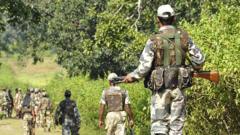Following the death of top Maoist leader Nambala Keshava Rao, India's government asserts progress against the long-standing insurgency. However, analysts suggest the complexity of the movement's social roots and ongoing political relevance may prolong the conflict.**
Assessing India's Ongoing Struggle Against Maoist Insurgency: A Contemporary Analysis**

Assessing India's Ongoing Struggle Against Maoist Insurgency: A Contemporary Analysis**
India's battle against Maoist insurgency sees significant developments as key leaders are neutralized, raising questions about the movement's future and relevance.**
After decades of armed conflict, India's protracted fight against Maoist insurgency is witnessing a pivotal moment. Recently, the government proclaimed a significant achievement with the elimination of Nambala Keshava Rao, better known as Basavaraju, alongside 26 others during a major military operation in Chhattisgarh. Home Minister Amit Shah hailed this operation as one of the most critical blows to the Maoist movement over the last three decades. Despite the success, concerns linger regarding the insurgency's future viability.
Maoists, identified with the Naxalite movement originating from West Bengal, have maintained an enduring presence across central and eastern India, often referred to as the "red corridor." The conflict has resulted in nearly 12,000 casualties since 2000, as reported by the South Asian Terrorism Portal. They argue their struggle represents the marginalized tribal and rural populations against historical state negligence and land grabs.
Officially branded as Left-Wing Extremism (LWE), the Maoist organizational framework was solidified in 2004 with the unification of various Marxist-Leninist factions. Former Prime Minister Manmohan Singh once labeled the Maoist insurgency as India's greatest internal security threat. As Prime Minister Narendra Modi's administration aims for a Maoism-free nation by 2026, the question arises whether the recent military successes mark a definitive decline or a temporary lull in the movement.
Opinions on the insurgency's trajectory vary. N Venugopal, an experienced journalist and observer of Maoism, asserts that the movement has historically demonstrated resilience, citing past leadership losses without end to Maoism. Conversely, MA Ganapathy, a prominent official overseeing counterinsurgency, believes the ideological appeal of Maoism has waned, particularly among younger generations who are less inclined to support armed rebellion.
Quantitative data reflects a dramatic decrease in Maoist-related violence, with violent incidents plummeting from 1,136 in 2013 to 594 in 2023, along with a consequential reduction in casualties. Despite this improvement, Chhattisgarh emerges as the most severely affected region, accounting for a vast majority of violence linked to Maoism, emphasizing the ongoing challenges in dismantling the remaining factions.
Interestingly, the strategy deployed by Indian security forces established a new paradigm. Enhanced coordination, intelligence-led operations, and improved police capability drastically shifted the operational landscape compared to a decade ago when law enforcement struggled against the insurgents. Access to technology has further diminished the Maoists' appeal, as communities become increasingly aware of the outside world.
However, some critics indicate a fundamental disconnect within the Maoist movement. While their earlier efforts managed to unite marginalized communities and secure social justice in specific regions, their inability to transition into a cohesive political movement underscores a tactical shortcoming. Their existing framework, which stresses isolated 'liberated zones', appears increasingly outdated in modern India, with calls for a more integrated approach between armed resistance and political engagement.
Although the CPI (Maoist) still holds some pockets of support, particularly within tribal areas across states like Odisha and Jharkhand, their military capacities are reportedly diminishing as ongoing crackdowns continue. Experts like Venugopal advocate for a restructured approach directed towards substantial dialogue with the government instead of continued bloodshed, suggesting that the insurgents may need to reevaluate their strategies to survive.
Lastly, the Maoists' ethos remains pivotal to understanding the conflict, particularly concerning territory rich in natural resources. The government is now taking steps to allow private access to these resources amidst the weakening insurgency, raising fresh concerns about the potential legacy of mass movements fighting against systemic socio-economic inequalities.
In conclusion, while significant strides against the Maoist insurgency have been made, the underlying social grievances and complex political dynamics imply that the fight against their ideology, rooted in historical injustices, may continue to evolve even without the framework of traditional Maoist leadership. An era of dialogue and political transition seems crucial for a sustainable resolution amid the movement's historical significance in India.


















